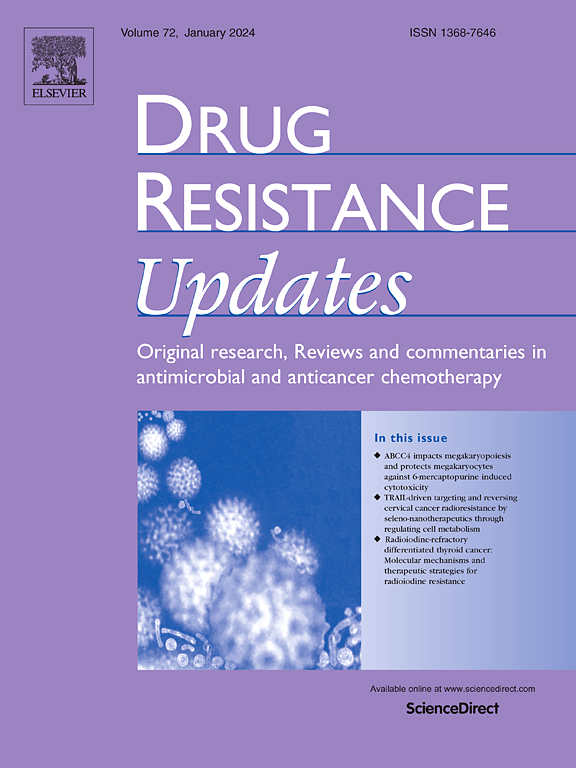B7-H3-liquid biopsy for the characterization and monitoring of the dynamic biology of prostate cancer
IF 15.8
1区 医学
Q1 PHARMACOLOGY & PHARMACY
引用次数: 0
Abstract
Background
B7-H3 is a promising target for cancer therapy, notably in prostate cancer (PCa), particularly in metastatic, castration-resistant PCa (mCRPC). With the development of B7-H3-targeted therapies, there is a need for a rapid, reliable, and cost-effective method to detect and monitor B7-H3 expression. Leveraging their abundance and stability, we developed a liquid biopsy assay using extracellular vesicles (EVs) for this purpose.
Methods
B7-H3+ EVs were isolated using a B7-H3 antibody-mediated, click chemistry-based enrichment method. Antibodies were conjugated to methyltetrazine-grafted microbeads. EVs were isolated from 100 µL of plasma from metastatic, castration-sensitive PCa (mCSPC) (n = 43) and mCRPC (n = 103) patients and quantified using RT-qPCR of ACTB. Measurements were compared with the patient's disease status over time.
Results
The assay detected higher B7-H3+ EVs in mCRPC than mCSPC and increased when mCSPC transitioned to mCRPC. Elevated B7-H3+ EVs were associated with lower overall survival (Hazard ratio (HR) 2.19, p = 0.01). In patients with serial plasma samples, B7-H3+ EV levels reflected treatment response and disease progression.
Conclusions
This B7-H3+ EV assay represents a significant advancement in utilizing tumor-derived EVs for a non-invasive, quantitative, and consistent real-time measurement of B7-H3. This assay warrants further development as a companion diagnostic for B7-H3 targeted therapies in PCa and other conditions.
b7 - h3液体活检用于前列腺癌动态生物学的表征和监测
db7 - h3是一种很有前景的癌症治疗靶点,特别是在前列腺癌(PCa),特别是转移性,去势抵抗性前列腺癌(mCRPC)中。随着B7-H3靶向治疗的发展,需要一种快速、可靠、经济的检测和监测B7-H3表达的方法。利用它们的丰度和稳定性,我们为此开发了一种使用细胞外囊泡(ev)的液体活检方法。方法采用B7-H3抗体介导的click化学富集方法分离sb7 - h3 + ev。抗体被偶联到甲基四嗪接枝的微珠上。从转移性去势敏感PCa (mCSPC) (n = 43)和mCRPC (n = 103)患者的100 µL血浆中分离ev,并使用ACTB的RT-qPCR进行定量。测量结果与患者一段时间内的疾病状况进行了比较。结果mCRPC中B7-H3+ EVs高于mCSPC,且在mCSPC向mCRPC过渡时EVs升高。B7-H3+ EVs升高与总生存率降低相关(风险比(HR) 2.19, p = 0.01)。在连续血浆样本的患者中,B7-H3+ EV水平反映了治疗反应和疾病进展。结论B7-H3+ EV检测在利用肿瘤源性EV进行无创、定量和一致的实时测量B7-H3方面取得了重大进展。该试验值得进一步发展,作为B7-H3靶向治疗前列腺癌和其他疾病的伴随诊断。
本文章由计算机程序翻译,如有差异,请以英文原文为准。
求助全文
约1分钟内获得全文
求助全文
来源期刊

Drug Resistance Updates
医学-药学
CiteScore
26.20
自引率
11.90%
发文量
32
审稿时长
29 days
期刊介绍:
Drug Resistance Updates serves as a platform for publishing original research, commentary, and expert reviews on significant advancements in drug resistance related to infectious diseases and cancer. It encompasses diverse disciplines such as molecular biology, biochemistry, cell biology, pharmacology, microbiology, preclinical therapeutics, oncology, and clinical medicine. The journal addresses both basic research and clinical aspects of drug resistance, providing insights into novel drugs and strategies to overcome resistance. Original research articles are welcomed, and review articles are authored by leaders in the field by invitation.
Articles are written by leaders in the field, in response to an invitation from the Editors, and are peer-reviewed prior to publication. Articles are clear, readable, and up-to-date, suitable for a multidisciplinary readership and include schematic diagrams and other illustrations conveying the major points of the article. The goal is to highlight recent areas of growth and put them in perspective.
*Expert reviews in clinical and basic drug resistance research in oncology and infectious disease
*Describes emerging technologies and therapies, particularly those that overcome drug resistance
*Emphasises common themes in microbial and cancer research
 求助内容:
求助内容: 应助结果提醒方式:
应助结果提醒方式:


